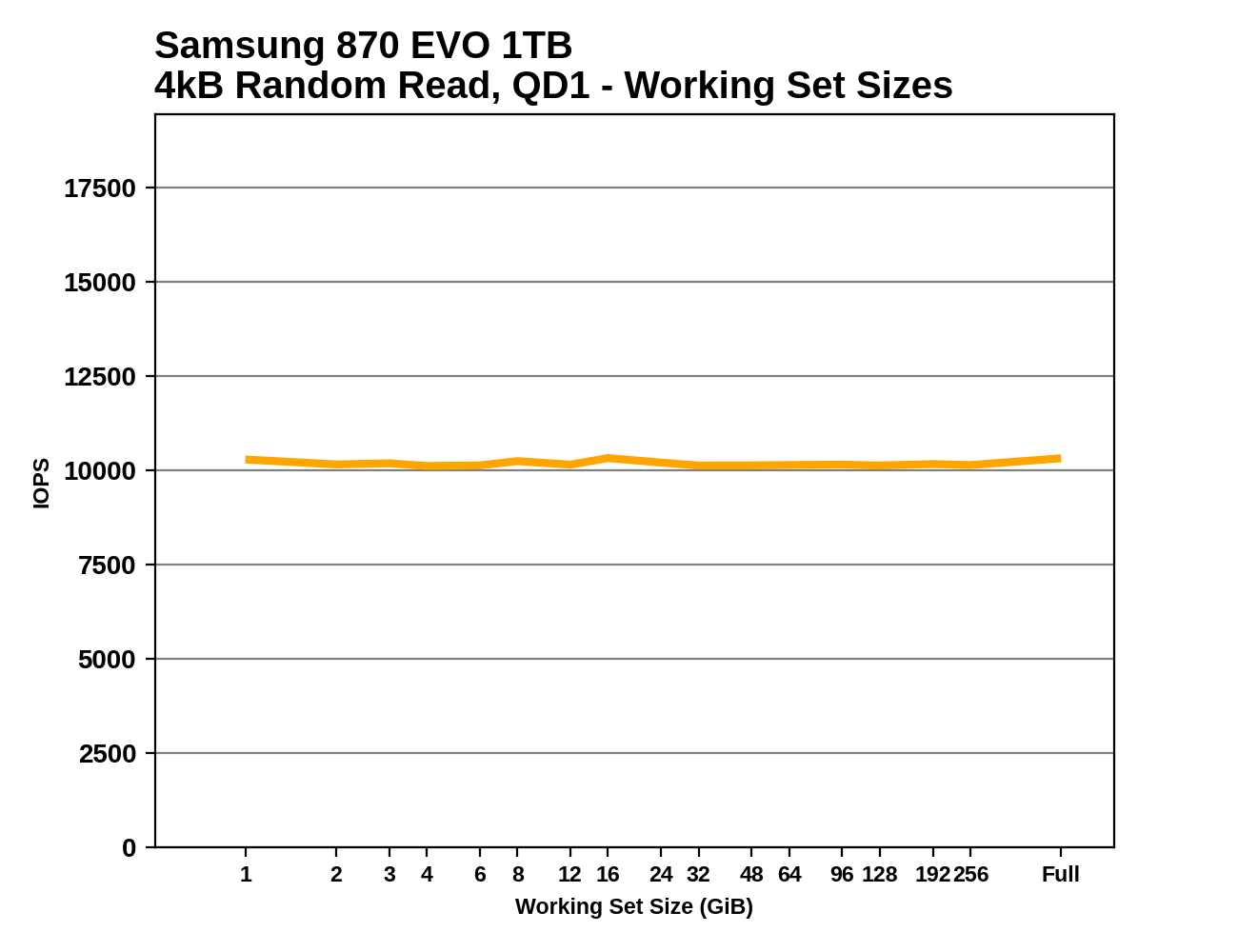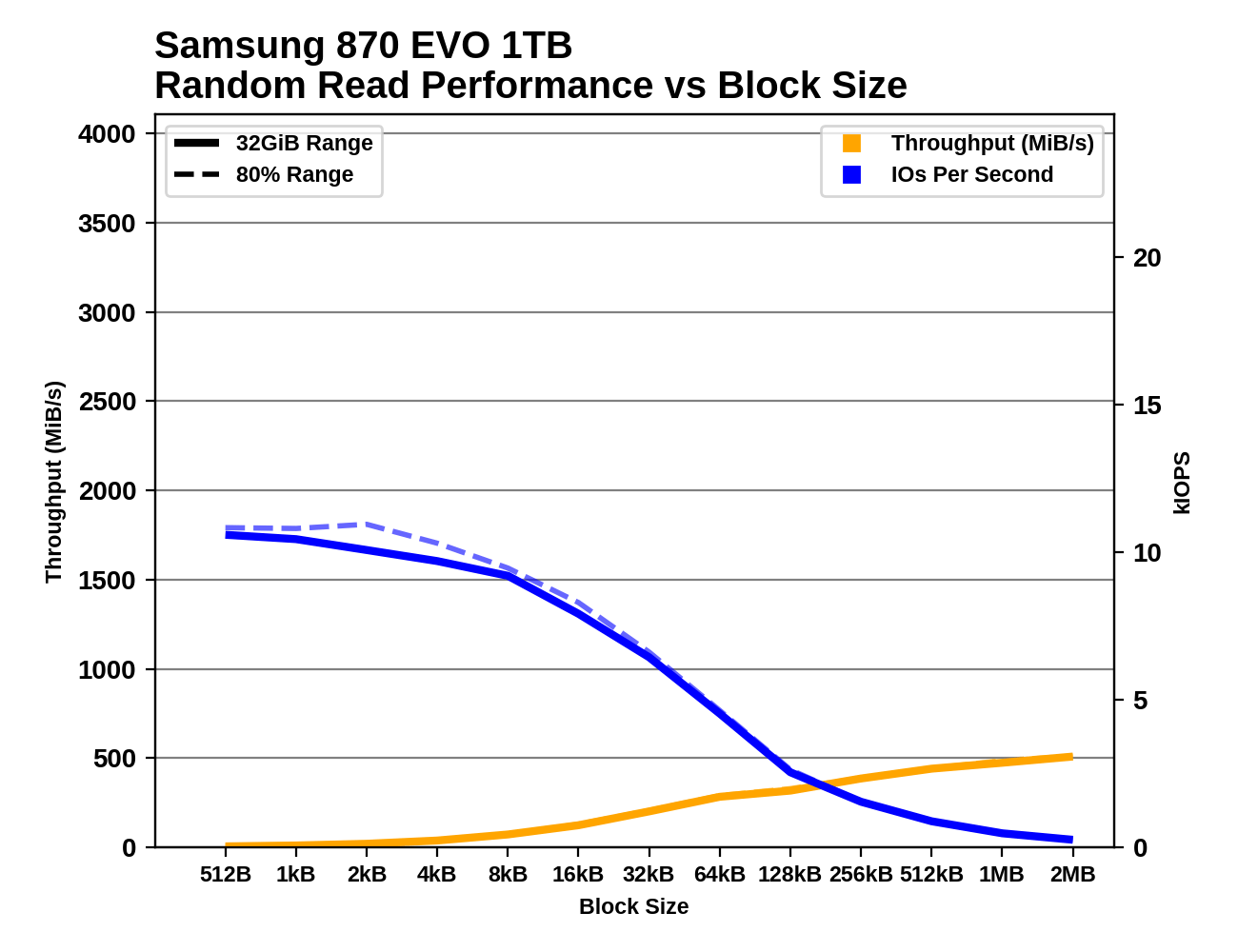The Samsung 870 EVO (1TB & 4TB) Review: Does the World Need Premium SATA SSDs?
by Billy Tallis on February 17, 2021 8:00 AM ESTAdvanced Synthetic Tests
Our benchmark suite includes a variety of tests that are less about replicating any real-world IO patterns, and more about exposing the inner workings of a drive with narrowly-focused tests. Many of these tests will show exaggerated differences between drives, and for the most part that should not be taken as a sign that one drive will be drastically faster for real-world usage. These tests are about satisfying curiosity, and are not good measures of overall drive performance. For more details, please see the overview of our 2021 Consumer SSD Benchmark Suite.
Whole-Drive Sequential Fill
 |
|||||||||
| Pass 1 | |||||||||
| Pass 2 | |||||||||
Some of our other tests have shown a few signs that the 870 EVO's write performance can drop when the SLC cache runs out, but this straightforward sequential write pass over the entire drive doesn't reveal any such behavior. The 870 EVO's sequential write performance is extremely consistent, even on the second write pass.
 |
|||||||||
| Average Throughput for last 16 GB | Overall Average Throughput | ||||||||
Due to the excellent performance consistency, the Samsung 870 EVOs edge out the other SATA drives with marginally higher average sequential write speeds. The entry-level NVMe drives end up much worse off than the mainstream SATA drives once their caches run out, but the more mainstream NVMe drive blows them all away.
Working Set Size
 |
|||||||||
As expected, the Samsung 870 EVO's random read performance shows basically no variation across a range of working set sizes, and that read performance is at least a little bit faster than any of the other SATA drives or the entry-level NVMe drives.
Performance vs Block Sizes
 |
|||||||||
| Random Read | |||||||||
| Random Write | |||||||||
| Sequential Read | |||||||||
| Sequential Write | |||||||||
There are no particular surprises in how the Samsung 870 EVO handles IOs of different block sizes. Unlike some drives, it has no trouble with sub-4kB IOs. It offers moderate improvements over the 860 EVO for mid-sized random reads (up to about 128kB). The one negative is that for writes we again see more inconsistency from the 870 EVO than the 860 EVO when testing an 80% full drive. The simple whole-drive sequential write test may not have been able to reveal any SLC caching troubles, but it does seem clear that the caching behavior has some performance regressions for more complicated workloads on a drive that's more well-used—though it's still unlikely to matter for any typical real-world consumer workload.










136 Comments
View All Comments
Spunjji - Friday, February 19, 2021 - link
They won't be using SATA - and it will be spread across a whole lot more than one single drive.dotjaz - Friday, February 19, 2021 - link
But they are using SATA, nobody said it's single drive. It's how much storage you can fit into a 1U rack that matters, SATA is the only choice at the moment.schujj07 - Wednesday, February 17, 2021 - link
That is 100% false. NVMe is only surface area limited in the M.2 form factor. However, 99% of users do not need more than a 4TB NVMe SSD. Those that need larger drives can use M.2 > U.2 converters and get much larger SSDs.Beaver M. - Wednesday, February 17, 2021 - link
Yeah well, look into most SATA SSDs, their PCB isnt bigger than that of a M.2 SSD. Plus M.3 is coming = more space.Also theres U.2, which pretty much allows to use 2.5"-sized SSDs to be used (even on a M.2 connector).
SATA is dead. And they know it, else they would have released a new standard very long ago.
nevcairiel - Wednesday, February 17, 2021 - link
The solution to that is called U.2, NVMe with a cable.flgt - Wednesday, February 17, 2021 - link
^^^CaedenV - Wednesday, February 17, 2021 - link
not really? You are typically limited to 8 or 16 chips with most SSDs, and you can hold that on a long double-sided m.2 just fine. If you are going with more than that then you are looking something extremely custom with a built in raid of some sort and that is going to be stupidly expensive and not for the consumer market.Just look at the pic of that 4TB board. Maybe 4 storage modules in it assuming there are 2 more on the other side? You can easily fit that on m.2 with room to spare.
flyingpants265 - Thursday, February 18, 2021 - link
Storage in general is kinda dead. People buy 2tb drives very reluctantly if they want to add space.DanNeely - Wednesday, February 17, 2021 - link
SATA as an SSD interface is going nowhere. SATA as an HDD interface probably has 5-10 years left before the price crossover finally kills spinning rust off.If at some point in the future we do see a new SATA spec; it'll be because mass market spinning rust for NASes has gotten fast enough to bottleneck: In which case they'll backport the faster transport parts of the 2x as fast SAS standard to make SATA4.
wicketr - Wednesday, February 17, 2021 - link
SATA at this point is need of major changes to keep up. They can't do a minor refresh at this point. With that in mind, I hope they change the cable so that it incorporates power into it as well. And they've got to shoot for something like 50Gb/s.At this point the latest USB spec is faster and provides power in a similar sized port. SATA should be able to beat that and it's a shame they haven't done so yet.